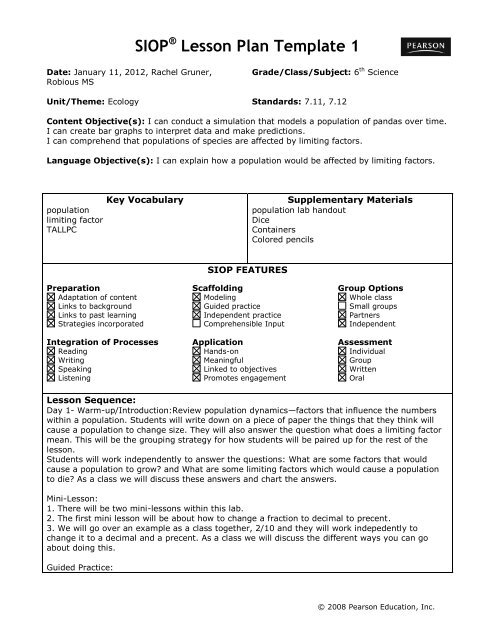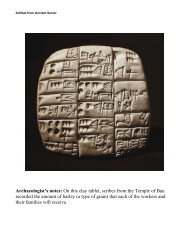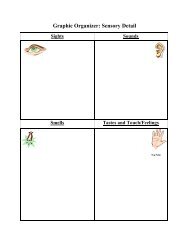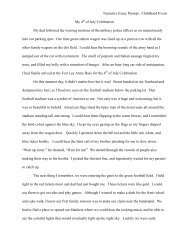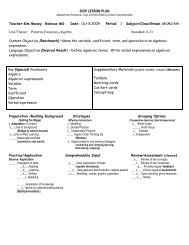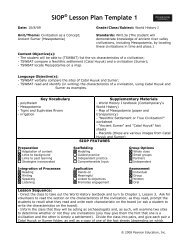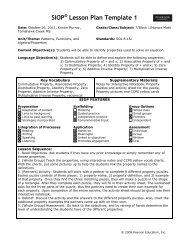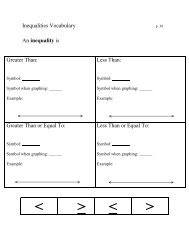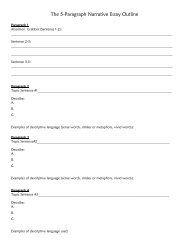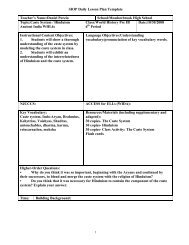SIOP® Lesson Plan Template 1 - ACT-ESL
SIOP® Lesson Plan Template 1 - ACT-ESL
SIOP® Lesson Plan Template 1 - ACT-ESL
- No tags were found...
You also want an ePaper? Increase the reach of your titles
YUMPU automatically turns print PDFs into web optimized ePapers that Google loves.
SIOP ® <strong>Lesson</strong> <strong>Plan</strong> <strong>Template</strong> 1Date: January 11, 2012, Rachel Gruner,Robious MSGrade/Class/Subject: 6 th ScienceUnit/Theme: Ecology Standards: 7.11, 7.12Content Objective(s): I can conduct a simulation that models a population of pandas over time.I can create bar graphs to interpret data and make predictions.I can comprehend that populations of species are affected by limiting factors.Language Objective(s): I can explain how a population would be affected by limiting factors.populationlimiting factorTALLPCKey VocabularySupplementary Materialspopulation lab handoutDiceContainersColored pencilsSIOP FEATURESPreparation Scaffolding Group OptionsAdaptation of content Modeling Whole classLinks to background Guided practice Small groupsLinks to past learning Independent practice PartnersStrategies incorporated Comprehensible Input IndependentIntegration of Processes Application AssessmentReading Hands-on IndividualWriting Meaningful GroupSpeaking Linked to objectives WrittenListening Promotes engagement Oral<strong>Lesson</strong> Sequence:Day 1- Warm-up/Introduction:Review population dynamics—factors that influence the numberswithin a population. Students will write down on a piece of paper the things that they think willcause a population to change size. They will also answer the question what does a limiting factormean. This will be the grouping strategy for how students will be paired up for the rest of thelesson.Students will work independently to answer the questions: What are some factors that wouldcause a population to grow? and What are some limiting factors which would cause a populationto die? As a class we will discuss these answers and chart the answers.Mini-<strong>Lesson</strong>:1. There will be two mini-lessons within this lab.2. The first mini lesson will be about how to change a fraction to decimal to precent.3. We will go over an example as a class together, 2/10 and they will work indepedently tochange it to a decimal and a precent. As a class we will discuss the different ways you can goabout doing this.Guided Practice:© 2008 Pearson Education, Inc.
SIOP ® <strong>Lesson</strong> <strong>Plan</strong> <strong>Template</strong> 11. As a class, students will read over the first simulation and work on figuring out the probabilityof survival (question 3). Once all students work has been checked then they may begin thesimulation 1.Application: Students will work with their group to complete the second simulation and answerthe limiting factor questions. Also students may work individually or together in order to find outthe probability of survival.Day 2- 2 nd Mini <strong>Lesson</strong>: Students will review the parts to a graph. The teacher will teach theacronymn TALLPC inorder to remember all the parts. T- Title, A- Axis, L- Label Axis, Label Units,P- Plot, C-Color.Guided Practice into independent: As a class we will work together to complete the title, axis,label of axis, label of units, and plotting the the first couple of points from the first simulation.Students will independently continue to finish the graph as the teacher walks arounddifferentiating for students who need help or finish up early.Closure: Students will refer back to the two original questions. what are some factors that wouldcause a population to grow? and What are some limiting factors that would cause a population todie? Individually they will add to their list based on their simulations then we will discuss as aclass what was added and why.Reflections:(Reproduction of this material is restricted to use with Echevarria, Vogt, and Short, 2008. Making ContentComprehensible for English Learners: The SIOP ® Model.)© 2008 Pearson Education, Inc.


